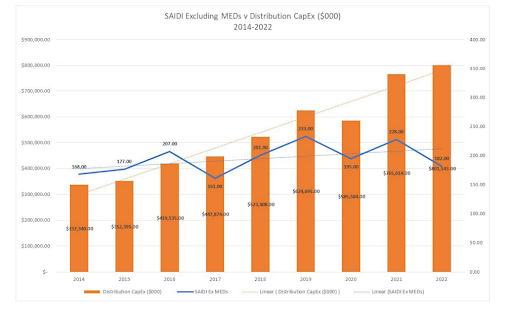On March 1, the Michigan Public Service Commission (MPSC) approved Consumers Energy’s latest electric rate case with an order that cut the rate increase by about 45% compared to what the utility had proposed. During the MPSC’s meeting Commissioner Alessandra Carreon explained one reason why the utility did not get all the spending approved for cost recovery that it wanted: “the company does not always demonstrate how each dollar spent toward restoration actually translates to shorter outages,” she said.
This lack of specificity about spending on the grid is a trend that goes well beyond this most recent rate case.
You’ve seen the commercials and heard the radio ads from DTE and Consumers Energy touting all they are doing to trim trees and harden the grid. It is an attempt to calm their angry customers who are sick of long and frequent outages.
CUB has been working to show that the facts about what the utilities are actually proposing to do to fix the grid do not support this public rhetoric from DTE and Consumers Energy. Our scrutiny of their spending proposals from rate cases can boil down to the conclusion that “more money does not mean better reliability.”
Now, we have focused these criticisms on the centerpiece of the second-largest electric utility in the state’s strategy for improving its poor level of reliability: Consumers Energy’s 2023 Electric Distribution Infrastructure Investment Plan (EDIIP), which was submitted for review by the MPSC last fall. Consumers describes the roughly 180-page EDIIP as the utility “anticipating the future needs of customers and developing an enhanced distribution strategy, informed by industry best practices from around the nation, that will deliver cost-effective reliability and resilience benefits.” Toward that end, Consumers Energy wants to spend $8.7 billion from 2024 to 2028 on the distribution grid, a plan that would lead to large rate increases for the utility’s customers – who have already been burdened by some of the most frequent rate increases in the country.
In comments on the EDIIP submitted to the MPSC, CUB, along with partnering organizations the Michigan Environmental Council, Natural Resources Defense Council and the Sierra Club, argue that the EDIIP “proposes to build a new house instead of fixing the roof.” The plan lists billions of dollars in projects to replace poles, convert lines to higher voltages, move lines underground, rebuild substations and much more, but does not tie these projects to any analysis of how each project would improve reliability, all the while ignoring much cheaper ways to make the grid more reliable.
The problem is Consumers Energy really does need to do the work to show that its big spending spree is going to make a dent in outages because, historically, that has not been the case. Our comments present the data (an example displayed below) showing that for years there has been no correlation between how much the utility has spent on the distribution grid and improvements in performance on key reliability metrics that measure the frequency and duration of outages.

A reason for this disconnect might be that Consumers Energy doesn’t appear to be interested in the most cost-effective, bang-for-your-buck grid investments – a pattern that is unfortunately still present in the EDIIP. Our comments describe many examples of this phenomenon. To detail one example, a significant portion of the EDIIP’s proposed spending is on replacing lines, poles and substation equipment that the utility judges to be at the end of their useful lives. But as our comments explain:
Replacing equipment because it is old or non-standard is insufficient justification for substantial capital improvements… Non-standard lines might be more costly to repair than standard lines, but that begs additional questions: how much more costly, do they fail more, are weaknesses detectable with inspections or technology and at what cost, and so on. An older Lincoln Town Car might cost more to maintain than a new Cadillac CTS but that is not enough to assess whether it should be replaced.
Meanwhile, the EDIIP overlooks the more cost-effective steps that would deliver the same or better reliability improvements as measures like expensive equipment replacements, but at lower cost to ratepayers. For example, automatic transfer reclosers (ATRs) are high-voltage electric switches that can sense problems like short circuits, automatically shut off power and automatically detect if the problem has been resolved and then restore power. Consumers Energy has deployed 147 ATR loops across the state, and in 2022, according to the EDIIP, 97 loops operated to avoid outages for 63,000 customers.
But despite this success, the EDIIP does not propose to increase the number of ATR loops. “Given the significant and cost-effective reliability benefits resulting from the existing ATR loops, combined with technological advances supporting expanded circuit eligibility, Consumers should be increasing ATR loop deployment rather than holding it static,” our comments said.
It is not just coincidental or due to incompetence that the utility focuses on the more expensive equipment replacements over the more cost-effective measures. Consumers Energy, a subsidiary of the publicly-traded company CMS Energy, collects a profit for shareholders on the capital it invests. The more capital, the more profit, so the more expensive the grid, the better for shareholders, if the utility can win regulatory approval to pass those capital investment costs to ratepayers. The utility has talked about its spending spree on the grid as a financial opportunity for shareholders before, and it is using the EDIIP to do so again. In a November 2023 presentation for investors, CMS described the EDIIP as a “capital investment opportunity.”
Our comments conclude that the MPSC should find that the EDIIP is flawed and “proactively and unequivocally disavow that it has ‘approved’ any spending proposals or other aspects of this (or any prior) EDIIP.” That step is important to ensure that Consumers Energy does not try to use the plan as a foundation to win regulatory approval for future rate increases. Next, the MPSC “should direct the utility to present more robust and credible plans “that would articulate how each program will achieve the claimed benefits and at what cost,” our comments said.

